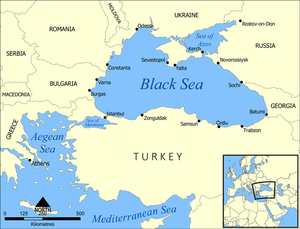Kerch
| Author:Laxman Burdak, IFS (R) |
Kerch Strait is a strait in Eastern Europe. It connects the Black Sea and the Sea of Azov, separating the Kerch Peninsula of Crimea in the west from the Taman Peninsula of Russia's Krasnodar Krai in the east.
Variants
- Cimmerian Bosporus (former name)
- Cimmerianus Bosporus
- Kerch Strait
- Strait of Kerch
- Kertch
- Russian: Керченский пролив,
- Ukrainian: Керченська протока,
- Crimean Tatar: Keriç boğazı,
- Adyghe: Хы ТӀуалэ
Jat clans
History
The most important harbor, the Crimean city of Kerch, gives its name to the strait, formerly known as the Cimmerian Bosporus. It has also been called the Straits of Yenikale after the Yeni-Kale fortress in Kerch.
Taman, the most important settlement on the Taman Peninsula side of the strait, sits on Taman Bay, which is separated from the main Kerch Strait by the Chushka Spit to the north and the former Tuzla Spit to the south; the Tuzla Spit is now Tuzla Island, connected to the Taman Peninsula by a 2003 Russian-built 3.8-kilometre-long (2.4 mi) dam, and to mainland Crimea by the Crimean Bridge opened in 2018. A major cargo port is under construction near Taman.
The straits are about 35 kilometers long and are 3.1 kilometers wide at the narrowest and separate an eastern extension of Crimea from Taman, the westernmost extension of the Caucasus Mountains. In antiquity, there seem to have been a group of islands intersected by arms of the Kuban River (Hypanis) and various sounds which have since silted up.[1] The Romans knew the strait as the Cimmerian Bosporus (Cimmerianus Bosporus) from its Greek name, the Cimmerian Strait (Κιμμέριος Βόσπορος, Kimmérios Bosporos), which honored the Cimmerians, nearby steppe nomads.[2] In ancient times the low-lying land near the Strait was known as the Maeotic Swamp.[3][4]
Mention by Pliny
Pliny[5] mentions.... Next to this, is the promontory of Cruni, after passing which, we find the Toretæ upon a lofty ridge of mountains. The city of Sindos17 is distant from Hierus sixty-seven miles and a half; after passing which, we come to the river Setheries. (6.) From thence to the entrance of the Cimmerian Bosporus the distance is eighty-eight miles and a half.
17 Inhabited by the Sindi, a people of Asiatic Sarmatia. They probably dwelt in and about the modern peninsula of Taman, between the Sea of Azof and the Black Sea, to the south of the river Hypanis, the modern Kouban. The site of their capital, Sindos, or Sinda, is supposed to have been the modern Anapa. Parisot conjectures that this place was one of the ancient settlements of the Zigeunes, the modern Bohemians or Gypsies. He seems to found his opinion upon some observations of Malte Brun (Précis de Geographie, vol. vi.) upon the origin of the Gypsy race, which will amply repay the perusal.
Mention by Pliny
Pliny the Elder, The Natural History
John Bostock, M.D., F.R.S., H.T. Riley, Esq., B.A., London, 1855.
Chap. 6. — The Cimmerian Bosporus
| Wikified by Laxman Burdak, IFS (R) |
The length of the peninsula1 which projects between the Euxine and Lake Mæotis, is not more than sixty-seven miles and a half, and the width across never less than two jugera:2 it has the name of Eion.3 The shores of the Bosporus then take a curve both on the side of Europe and of Asia, thus forming the Mæotis. The towns at the entrance of the Bosporus are, first Hermonassa4, next Cepi5, founded by the Milesians, and then Stratoclia and Phanagoria6, and the almost deserted town of Apaturos7, and, at the extremity of the mouth, Cimmerium 8, which was formerly called Cerberion. (7.) We then come to Lake Mæotis, which has been already mentioned9 in the description of Europe.
Foot Notes
1 The peninsula on which Taman or Timoutarakan is situate.
2 The jugerum was 100 Grecian or 104 Roman feet in length.
3 Signifying in Greek the "sea-shore."
4 Lying between Singa and Phanagoria. Rennell fixes it at the opening of the lake into which the Kouban flows.
5 Or the "gardens," from the Greek κῆποι. A town of the Cimmerian Bosporus, founded by the Milesians. Dr. Clarke identifies the modern Sienna with it, and the curious Milesian sculptures found there confirm the supposition.
6 Its ruins are supposed to be those near Taman, on the eastern side of the Straits of Kaffa. It was the great emporium for all the traffic between the coasts of the Palus Mæotis and the countries on the south of the Caucasus, and was chosen by the kings of Bosporus as their capital in Asia.
7 A town of the Sindæ; it possessed, like Phanagoria, a celebrated temple of Aphrodite Apaturos, or Venus "the Deceiver," whence probably its name.
8 Clarke identifies it with the modern Temruk, but Forbiger with Eskikrimm.
9 See B. iv. c. 24.
External Links
References
- ↑ Minns, Ellis (1911). "Bosporus Cimmerius". In Chisholm, Hugh (ed.). Encyclopædia Britannica. Vol. 4 (11th ed.). Cambridge University Press. pp. 286–287.
- ↑ Anthon, Charles (1872) "Cimmerii" A Classical Dictionary: Containing an Account of the Principal Proper Names Mentioned in Ancient Authors (4th ed.) pp. 349–350.
- ↑ https://everything2.com/title/Hun
- ↑ "Etruscan_Phrases, research providing new insight into Indo-European languages". Maravot.com. 13 February 2009.
- ↑ Natural History by Pliny Book VI/Chapter 5
Back to Places
